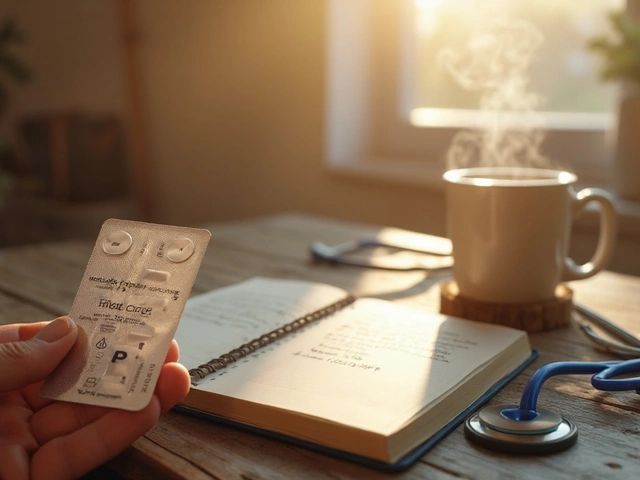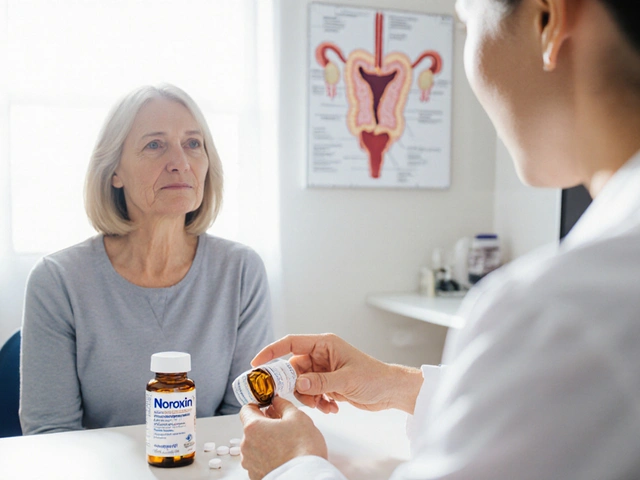Fosamax for Osteoporosis: Benefits, Side Effects, and Patient Tips

If you’ve heard about cracks that show up in your bones as you get older, you’re not alone. Osteoporosis is sneaky—it hits millions, especially women past menopause, but men aren’t safe either. We worry about breaking a hip or a wrist, but it’s more than just a pain—these fractures can flip your world upside down. Today, let’s talk about one of the most used medicines for this problem: Fosamax. This pill is almost like a bone bodyguard, but not everyone knows how it works or what comes with it. Dig in for some eye-openers, myths busted, and tips that actually help.
What is Fosamax and How Does It Actually Work?
Fosamax is the brand name for alendronate, an oral bisphosphonate that doctors love to prescribe for osteoporosis and some other bone-thinning conditions. When you take it, alendronate sticks to your bones and tells special cells called osteoclasts to chill out. These cells are usually responsible for breaking down older bone, but with age or after menopause, they get a little too enthusiastic. Over time, bones thin faster than your body can rebuild them. Here’s where Fosamax steps in—it slows the breakdown and gives your bones a fighting chance to get denser and stronger.
Pretty much all the big guidelines—including the National Osteoporosis Foundation and the International Osteoporosis Foundation—list Fosamax on their first-choice list for women with postmenopausal osteoporosis who are at risk for fractures. That’s not just theory; studies have shown Fosamax boosts bone mineral density (BMD) in the spine by roughly 5-8% within three years of regular intake. Not bad, right?
But, there’s a catch. Fosamax only works if you take it correctly. If you pop that pill and lie down or eat right away, you can kiss most of its benefits goodbye. The way this drug moves through your stomach means you have to take it first thing in the morning, on an empty stomach, and then stand or sit up (no slouching!) for 30 to 60 minutes. Swallow it with a full glass of plain water—no coffee, juice, or even mineral water. You’d be surprised how skipping these steps can really mess up how much of the medicine your bones soak up.
Check this out—the effectiveness of Fosamax is dose-dependent, but it’s also about sticking with the plan. Here’s a real dilemma: lots of people stop taking it after a year or so either because they forget, feel fine, or worry about side effects. But researchers say the biggest cuts in fracture risk (think: about half as many spinal fractures) happen when folks take the drug for at least three years, sometimes even five, under supervision.
So what can you actually expect if you start Fosamax today? The drug doesn’t build new bone—it keeps what you’ve got from disappearing too fast. Some people notice aches or stiffness in their joints, but for many, it just rolls along in the background, quietly working. Getting a follow-up bone scan after a couple of years will show you if your skeleton is in better shape than where it started, and you can bet your doctor will have you do just that.
Fosamax Benefits: What Do Real Patients and Studies Say?
We all want to know: will this pill actually make a difference you can see and feel? Clinical trials say yes. Let’s cut to the chase—with three to five years of Fosamax, the risk of hip fractures in postmenopausal women with osteoporosis drops about 40-50%. That’s not just some little number, it’s huge when you consider that hip fractures are linked to a loss of independence and a high risk of complications down the line.
For spine fractures (vertebrae, which often crush down over time if you’ve got weak bones), Fosamax can cut the risk by up to 70%. That’s not just marketing—these numbers come out of studies with thousands of real patients, like the Fracture Intervention Trial (FIT), one of the largest and longest-lasting bone health studies out there.
Data table time—here’s a breakdown of Fosamax’s impact based on research:
| Benefit | Fosamax Group | Placebo Group | Relative Reduction |
|---|---|---|---|
| Hip Fracture Rate (3 yrs) | 1.0% | 2.2% | ~55% |
| Spine Fracture Rate (3 yrs) | 4.8% | 14.0% | ~66% |
| BMD Increase (Lumbar Spine) | +6.2% | -1.6% | 7.8% advantage |
Those are pretty convincing numbers. But let’s talk about how people actually feel on Fosamax. Most don’t notice a “quick bone fix”—bone density changes are slow and subtle. However, if you combine Fosamax with vitamin D, calcium, and movement (like walking or strength training), you boost the odds of seeing those stats translate into real-world results. If your fall risk drops and so do your chances of bone breaks, that means you’re doing something right.
There’s also something practical here—Fosamax comes in weekly pills, not every day. The weekly tablet (70 mg once a week) is as powerful as smaller daily doses but much more convenient for folks who forget daily meds. That’s made a real difference in patients actually sticking with it.
Another advantage to mention: the generic version, alendronate, is affordable. Many health insurance plans cover it, but even the out-of-pocket cost for the generic is lower than it was years ago—often just a few dollars a month.

Fosamax Side Effects and Risks: What’s Fact and What’s Hype?
If you search for side effects of Fosamax, it can look downright scary—jaw bones crumbling, thighs snapping, weird heart issues. But let’s break down what’s rare, what’s real, and what’s just social media horror stories.
The most common complaints with Fosamax are digestive: heartburn, stomach pain, gas, and sometimes nausea. Remember the standing-up rule? That’s not for fun—it’s to keep that acid from burning your throat or esophagus. Some folks get aches in muscles or joints, but usually these go away after a week or so.
Rare side effects do exist and get a lot of attention. One is osteonecrosis of the jaw (ONJ). This scary-sounding thing mostly happens in cancer patients on huge doses or those getting dental work while on long-term bisphosphonates. For someone using Fosamax for osteoporosis, that risk is tiny—think about 1 in 10,000 or even lower. Good oral hygiene and seeing a dentist before starting can almost erase this risk.
Another rare issue is “atypical femur fractures,” which can happen when people stay on these medicines for over five years. The odds are low (about 1 in 1,000 after five years), but doctors now give patients “drug holidays”—breaks from Fosamax after 3-5 years in low-risk people to let bones reset.
People with severe kidney problems shouldn’t use Fosamax, and it’s not a fit for those who can’t stay upright after swallowing it. Pregnant women or kids shouldn’t touch this drug.
There have been a few case reports about potential links between Fosamax and heart rhythm issues, especially something called atrial fibrillation, but big studies haven’t shown a clear connection. If you have heart rhythm problems, mention it to your doctor before starting. For most, this isn’t an issue.
If you’re worried about anything weird after taking Fosamax (like sudden jaw pain, thigh aches, or long-term stomach pain), bring it up fast. Sometimes a simple switch in meds or schedule solves the problem. And don’t forget—never stop these kinds of medications without talking to your healthcare provider, because quitting cold turkey can raise your fracture risk if your bones aren’t strong yet.
Practical Tips for Living Well on Fosamax
So your doc hands you a prescription—now what? Skip the stress and use these tips to stay on track and avoid the common pitfalls.
- Set alarms on your phone for your weekly dose—missing pills messes up the progress.
- Take Fosamax first thing in the morning, with a full glass (8 oz) of plain water—no lying down, no coffee, no food for at least 30 minutes.
- If you miss your morning dose, skip it entirely. Don’t double up or take it later in the day—it just increases side effect risks.
- Get your dentist on speed dial. Have any dental work done before you start, or let your dentist know you’re taking it, especially if you need extractions or implants.
- Add calcium (1,000-1,200 mg daily) and vitamin D (at least 800 IU per day) unless your doctor tells you otherwise. Spread the calcium throughout the day—not all at once.
- Mix in bone-healthy activities—think walking, stair climbing, or lifting light weights. Bone grows with resistance, so don’t go too easy on yourself.
- Watch for side effects, but don’t let internet horror stories spook you off your meds without a real talk with your doctor.
- Plan ahead for “drug holidays.” After three to five years, your doctor may suggest a break if your risk is low. This is safe and smart for many people.
- Stay up to date on yearly check-ins. A DEXA scan—a painless X-ray for bone density—is your scoreboard. If your T-score improves or holds steady, you’re on the right path.
Stick with these routines, and the boring little pill can actually save your hips, your back, and a whole lot of trouble down the road. Do the basics right, and you’ll give the drug—and your body—a fair shot at building a stronger foundation, year after year.






Raja Asif
May 30, 2025 AT 00:28Listen, the pharma giants love pushing Fosamax like it’s a miracle cure, but they hide the real cost behind glossy ads. The drug works only if you become a disciplined robot – empty stomach, water only, standing upright for an hour. Miss one step and you’re throwing money away while the bone‑break risk stays high. And don’t be fooled by the “first‑choice” label; it’s a market strategy to lock you into a lifelong subscription. The real battle is getting patients educated enough to follow the regimen, not just signing a prescription and walking away.
Matthew Tedder
June 7, 2025 AT 11:20It’s easy to feel overwhelmed by all the rules, but think of them as a simple safety net. Taking the pill with a full glass of water first thing keeps the stomach from irritation. Consistency really does cut fracture risk, especially after those first few years. If you can set a reminder, you’ll be giving your bones the steady support they need.
Cynthia Sanford
June 15, 2025 AT 22:23Totally love how easy the weekly pill is!
Yassin Hammachi
June 24, 2025 AT 09:26When we examine the essence of medication adherence, we’re really probing the relationship between habit and health. The ritual of rising, drinking water, and staying upright creates a mindfulness that extends beyond the pill itself. It’s a small ceremony that reminds us our bodies require intentional care. Moreover, the data on reduced hip fractures is not just statistical noise; it reflects a tangible shift in quality of life. By integrating calcium and vitamin D, we amplify the bone‑building orchestra that Fosamax conducts. Regular weight‑bearing exercise adds another movement to this symphony, reinforcing skeletal resilience. In the end, the protocol is a partnership – the drug does its part, and we do ours.
Michael Wall
July 2, 2025 AT 20:30We have to ask ourselves if we’re comfortable letting a chemical keep our bones from crumbling. The guidelines are clear, yet many skip the dentist visit and ignore the standing rule. Skipping those steps can lead to esophageal irritation, which is a preventable harm. It’s not just about the numbers; it’s about respecting our bodies. If you’re not willing to follow the simple instructions, maybe a different approach is needed.
Christopher Xompero
July 11, 2025 AT 07:33Honestly, the drama around Fosamax is overblown. People read the worst‑case scenarios on forums and freak out. The drug is tried‑and‑tested, and the rare side effects are just that – rare. If you’re scared, talk to your doc, not your conspiracy‑theory subreddit. Trust the science, not the sensational headlines.
Irene Harty
July 19, 2025 AT 18:36While the majority of patients experience minimal adverse effects, the possibility of osteonecrosis of the jaw warrants rigorous scrutiny. It is imperative to obtain a thorough dental evaluation prior to initiation. Moreover, any invasive dental procedures should be postponed until after a sufficient drug‑holiday period. I recommend documenting all oral health interventions to mitigate unforeseen complications.
Jason Lancer
July 28, 2025 AT 05:40Fosamax can be a solid option, but it’s not a magic bullet. If you don’t pair it with lifestyle changes, the benefits dwindle.
Brooks Gregoria
August 5, 2025 AT 16:43Everyone’s quick to hail Fosamax as the holy grail, but the long‑term data still leaves gaps. Why do we keep prescribing a drug that can cause atypical femur fractures after a few years? The industry pushes a “drug holiday” as a Band‑Aid, not a solution. We should be questioning the reliance on a single medication for bone health. Diversifying treatment strategies would be wiser than clinging to a lone pill.
Sumit(Sirin) Vadaviya
August 14, 2025 AT 03:46Great rundown! 👍 Keep those tips handy and stay consistent. Your bones will thank you.
lindsey tran
August 22, 2025 AT 14:50Seriously, the weekly schedule is a lifesaver. I used to forget daily meds all the time, but the reminder on my phone makes it painless. And yes, the water‑first rule feels weird at first, but once you get used to it, it’s second nature. Stick with it and you’ll see the difference.
Krishna Sirdar
August 31, 2025 AT 01:53Let’s remember that medication is just one piece of the puzzle. Good nutrition, safe sunlight for vitamin D, and even community walking groups can boost bone strength. If you’re new to this, start with small, consistent steps and watch your confidence grow. I’ve seen many patients thrive when they pair the pill with a supportive environment.
becca skyy
September 8, 2025 AT 12:56Totally agree, the practical tips are spot on. No need to overthink it – just set that alarm, drink the water, and move.
Theo Roussel
September 17, 2025 AT 00:00From a pharmacokinetic perspective, alendronate’s affinity for hydroxyapatite facilitates its selective deposition in active remodeling sites. This mechanism underpins the observed BMD gains in the lumbar spine. However, the esophageal mucosal exposure risk necessitates strict administration protocols to mitigate gastro‑esophageal irritation. Clinicians should also monitor serum calcium and renal function periodically.
Erick Masese
September 25, 2025 AT 11:03One must commend the elegance of bisphosphonate therapy – a sleek, once‑weekly regimen that dovetails nicely with modern lifestyles. Yet, the simplicity should not lull patients into complacency; adherence remains paramount. Consider the pill a keystone in a broader arch of bone health, not the sole pillar.
Matthew Charlton
October 3, 2025 AT 22:06Stick to the routine, track your progress with periodic DEXA scans, and celebrate each small improvement. Support from friends or online groups can keep motivation high.
Pamela may
October 12, 2025 AT 09:10Okay, let me unpack this whole Fosamax saga for anyone still on the fence. First off, the drug’s primary mission is to calm down those overly enthusiastic bone‑eating cells, which, if left unchecked, turn our skeletons into fragile paper mâché. The clinical trials are pretty solid – we’re talking about a 40‑50% drop in hip fractures after a few years of disciplined use. But, and there’s always a but, you have to respect the strict intake protocol: empty stomach, a full glass of water, and then stay upright like a statue for at least half an hour. Forget any of that, and you’re basically inviting digestive fireworks, which nobody needs. Secondly, the side‑effect profile is generally mild: think occasional heartburn, maybe a fleeting muscle ache, and that’s it for most folks. The notorious jaw necrosis and atypical femur fractures are real, but they’re astronomically rare outside of high‑dose cancer settings. Dental hygiene is key – get a clean bill of health before you start, and keep your dentist in the loop. Now, about that “drug holiday” concept – after three to five years, your doctor may suggest a break if your fracture risk is low; this helps the bone remodeling cycle reset and reduces the minuscule long‑term risks. Pair the pill with calcium and vitamin D, and don’t underestimate the power of simple weight‑bearing exercises like brisk walks or light resistance work. These lifestyle tweaks amplify the medication’s benefits dramatically. If you’re forgetful, set a weekly alarm; the habit becomes second nature faster than you think. Lastly, keep your follow‑up DEXA scans on schedule – they’re your scoreboard, showing whether the gamble is paying off. In short, Fosamax is not a miracle cure, but it’s a reliable ally when you play by the rules, combine it with good nutrition, stay active, and stay on top of medical advice. Stick with it, and you’ll likely dodge those nasty fractures that can upend your independence.